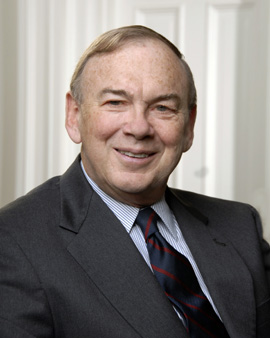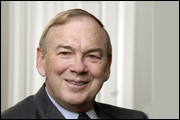President Bennet to Step Down
| Posted 05/04/06 |
| Wesleyan President Doug Bennet will conclude his presidency at the end of the 2006-07 academic year, he informed faculty, students and staff on May 4.
“Wesleyan is doing well, both institutionally and in its daily pursuit of excellence,” Bennet said to members of the campus community gathered at the steps of North College. “The university is prepared well to engage new leadership, and the time is right for Midge and me to move ahead to the next phase of our lives.” Bennet praised the ongoing work of Wesleyan’s faculty in envisioning and implementing a liberal arts and sciences curriculum intended to engage students with the world around them and to enable them to become leaders. He also cited the strategic planning processes that have mobilized the campus and alumni communities around clear institutional priorities. “Universities progress in several ways,” he said. “There are big turning points that affirm fundamental institutional commitments. The work we did to define a Wesleyan education for the 21st century, to improve student aid, to add faculty, and to begin a process of campus renewalall of these show that Wesleyan can make big decisions and act upon them.” He added: “The daily progress of an educational community is ongoing and never-ending–the discovery, the teaching, the care and respect for all within the community. New students arrive every year; new issues come to the fore. They show who we really are, especially in making good on the potential of our diversity. They help individual students define their values and learn the confidence that will empower them as change-makers.” Midge Bennet thanked the assembled students, faculty and staff. She added that, even after their retirement, she and the president would look forward to “lectures and sporting events, as well as lunch at the new Usdan University Center.” We will continue helping Wesleyan in any way we can, she said. James van B. Dresser ’63, chair of Wesleyan’s Board of Trustees, was on hand to thank and congratulate the Bennets. “The hallmark of Doug’s tenure has been his ability to forge a strategic direction for the institution,” Dresser said. “Through cycles of planning and action, Doug has moved Wesleyan forward. His well-placed faith in the willingness of alumni, parents, and friends of the college to fund plans they believed in has brought Wesleyan important new resources. The school has never been stronger, and thanks to his leadership, the Wesleyan community has the pride and confidence to move from strength to strength.”
Dresser assured those assembled he would consult the Board of Trustees immediately about plans for a presidential search. “I promise that we will keep the campus community fully informed about this process, and that we will keep students, faculty and staff meaningfully involved,” he said. Bennet’s LegacyDouglas J. Bennet 59 was elected the 15th president of Wesleyan University on April 7, 1995, and began his tenure on July 1, 1995. He was U.S. assistant secretary of state for international organization affairs when tapped by Wesleyan, though he was best known for his decade (1983-93) as chief executive officer and president of National Public Radio. Once installed as Wesleyan’s president, Bennet led the university community through its first-ever strategic planning process, a comprehensive effort that included faculty, staff and students, alumni and parent leaders. This process yielded a vision for liberal education in times of rapid change. “Wesleyan Education for the Twenty-First Century” (1997) sought to define the essential capabilities of an educated person and established the principles on which to make ongoing curricular choices. It affirmed the value of scholarship and teaching in a residential community and confirmed that knowing how to learn is the most durable legacy of a Wesleyan education. The process also produced “Strategy for Wesleyan” (1998), which defined key institutional priorities: an enduring commitment to need-blind admission and thus to building the University’s student aid program; an expansion of the faculty in order to improve teaching ratios and expand scholarship and teaching in new, interdisciplinary areas; and the beginning of a program of campus renewal. To view Bennet’s accomplishments, including his efforts with strategic planning, student aid, faculty additions, campus renewal, fund-raising, endowment management, technology and athletics, visit http://www.wesleyan.edu/administration/president/accomplishments.html. These priorities became the foundation for the $281 million Wesleyan Campaign, by far the most successful fund-raising effort in the university’s history. The campaign garnered contributions from 68 percent of Wesleyan’s alumni. Total gifts in a single year tripled, from $10.4 million in 1995 to $31.3 million in 2005. As the campaign concluded in 2004, Bennet led a second strategic planning exercise. The second strategy, “Engaged with the World” (2005), describes priorities for the period 2005-2010, including continuing curricular innovations and renewed commitments to international studies and to science. It outlines priorities for academics, campus life, student aid, and physical infrastructure. Bennet’s emphasis on planning and on strict allocation of budget resources according to the priorities thus established has enabled Wesleyan to devote the highest proportion of its total spending to teaching and research and the lowest to administration among the top 50 schools in the annual rankings produced by U.S. News and World Report. It has enabled Wesleyan to compete for students and faculty against much better-endowed institutions. It also has enabled the University to maximize the impact of fund-raising and borrowing to invest in strategic priorities, while almost doubling the market value of its endowment during his presidency. The Bennet presidency also represented a new era of collaboration with the city of Middletown. Under Bennet’s leadership, Wesleyan participated actively in the city’s development efforts, including investing University funds to bring to the city a downtown hotel, the 100-bed Inn at Middletown, which opened in 2003. Wesleyan established the Green Street Arts Center, a community arts center in the city’s North End, offering classes and workshops for children and adults in music, visual arts, dance, theater, literary and media arts. The center, a collaboration with the city of Middletown and the North End Action Team, is an important part of efforts to revitalize the city’s North End. “I think they will be talking about Doug Bennet’s legacy for many generations to come,” said Alan Dachs ’70, chair of Wesleyan’s Development Committee who also served as chair of the Board of Trustees from 1997 to 2005. “He did an outstanding job as our president. He will be very hard to replace. Everything we value most has been improved under his leadership. Financial aid packages are better, and the academic enterprise is more robust. He has raised more money than ever before in our history, and our investment returns are in the top quartile. Everything he was asked to do, he did and more, much more.” In January 2006, the Andrew W. Mellon Foundation made a grant of $200,000 to Wesleyan in honor of Doug Bennet’s service to the university over the past 10 years. The grant created an endowment that will support an annual lecture and program focused on ethics, politics and society. |
| By Justin Harmon, director of University Communications |


 Bennet, who became president in April 1995, led Wesleyan’s historic $281 million capital campaign, expanded the size of the faculty, launched an ambitious campus building program, and shaped the universitys first comprehensive strategic plan.
Bennet, who became president in April 1995, led Wesleyan’s historic $281 million capital campaign, expanded the size of the faculty, launched an ambitious campus building program, and shaped the universitys first comprehensive strategic plan. Dresser called Midge Bennet “for many of us
the wisest and warmest counselor and friend we have known.” He added: “Her undying faith in our common purpose and our bright future have inspired all who have had the good fortune to come into contact with her in any setting, over all these years.”
Dresser called Midge Bennet “for many of us
the wisest and warmest counselor and friend we have known.” He added: “Her undying faith in our common purpose and our bright future have inspired all who have had the good fortune to come into contact with her in any setting, over all these years.”